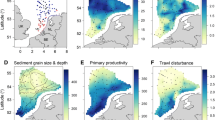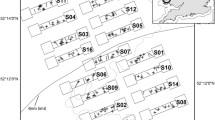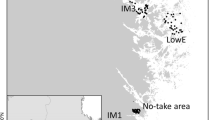Abstract
The Ecosystem Approach to Fisheries requires that managers take account of the environmental impacts of fishing. We develop linked state and pressure indicators that show the impact of bottom-trawling on benthic communities. The state indicator measures the proportion of an area where benthic invertebrate biomass (B) or production (P) is more than 90% of pristine benthic biomass (B 0.9) or production (P0.9). The pressure indicator measures the proportion of the area where trawling frequency is sufficiently high to prevent reaching predicted B0.9 or P0.9. Time to recovery to B0.9 and P0.9 after trawling, depending on the habitat, was estimated using a validated size-based model of the benthic community. Based on trawling intensity in 2003, 53.5% of the southern North Sea was trawled too frequently for biomass to reach B0.9, and 27.1% was trawled too frequently for production to reach P0.9. As a result of bottom-trawling in 2003, in 56% of the southern North Sea benthic biomass was below B0.9, whereas in 27% of the southern North Sea benthic production was below P0.9. Modeled recovery times were comparable to literature estimates (2.5 to more than 6 years). The advantages of using the area with an ecological impact of trawling as a pressure indicator are that it is conceptually easy to understand, it responds quickly to changes in management action, it can be implemented at a relevant scale for fisheries management, and the necessary effort distribution data are centrally collected. One of this approach’s greatest utilities, therefore, will be to communicate to policy makers and fishing enterprises the expected medium- to long-term ecological benefits that will accrue if the frequency of trawling in particular parts of fishing grounds is reduced.




Similar content being viewed by others

References
Auster PJ, Langton RW. 1999. The effects of fishing on fish habitat. In: Benaka LR, editor. Fish habitat: essential fish habitat and rehabilitation. Hartford (CT): American Fisheries Society. p 150–87
Beukema JJ. 1995. Long-term effects of mechanical harvesting of lugworms Arenicola marina on the zoobenthic community of a tidal flat in the Wadden Sea. Netherlands J Sea Res 33:219–27
Beukers-Stewart BD, Vause BJ, Mosley MWJ, Rossetti HL, Brand AR. 2005. Benefits of closed area protection for a population of scallops. Mar Ecol Progr Ser 298:189–204
Blyth RE, Kaiser MJ, Edwards-Jones G, Hart PJB. 2004. Implications of a zoned fishery management system for marine benthic communities. J Appl Ecol 41:951–61
Boyd SE, Limpenny DS, Rees HL, Cooper KM, Campbell S. 2003. Preliminary observations of the effects of dredging intensity on the re-colonisation of dredged sediments off the southeast coast of England (Area 222). Estuar Coast Shelf Sci 57:209–23
Brown JH, West GB. 2000. Scaling in biology. Oxford (UK): Oxford University Press
Choi JS, Frank KT, Leggett WC, Drinkwater K. 2004. Transition to an alternate state in a continental shelf ecosystem. Can J Fish Aquat Sci 61:505–10
Collie JS, Hall SJ, Kaiser MJ, Poiner IR. 2000. A quantitative analysis of fishing impacts on shelf-sea benthos. J Animal Ecol 69:785–98
Costanza R, d’Arge R, de Groot R, Farber S, Grasso M, Hannon B, Limburg K, et al. 1997. The value of the world’s ecosystem services and natural capital. Nature 387:253–60
Daan N. 2005. An afterthought: ecosystem metrics and pressure indicators. ICES J Mar Sci 62:612–13
Dinmore TA, Duplisea DE, Rackham BD, Maxwell DL, Jennings S. 2003. Impact of a large-scale area closure on patterns of fishing disturbance and the consequences for benthic communities. ICES J Mar Sci 60:371–80
Duplisea DE, Jennings S, Warr KJ, Dinmore TA. 2002. A size-based model of the impacts of bottom trawling on benthic community structure. Can J Fish Aquat Sci 59:1785–95
Food and Agricultural Organization [FAO]. 2003. Fisheries management. 2. The ecosystem approach to fisheries. Rome: FAO. 121 p
Garcia SM, Staples DJ. 2000. Sustainability reference systems and indicators for responsible marine capture fisheries: a review of concepts and elements for a set of guidelines. Mar Freshw Res 51:385–426.
Hall SJ. 1999. The effect of fishing on marine ecosystems and communities. Oxford (UK): Blackwell
Hall SJ, Mainprize B. 2004. Towards ecosystem based fisheries management. Fish Fisheries 5:1–21
Hermsen JM, Collie JS, Valentine PC. 2003. Mobile fishing gear reduces benthic megafaunal production on Georges Bank. Mar Ecol Progr Ser 260:97–108
Hiddink JG, Jennings S, Kaiser MJ, Queirós AM, Duplisea DE, Piet GJ. 2006. Cumulative impacts of seabed trawl disturbance on benthic biomass, production and species richness in different habitats. Can J Fish Aquat Sci. 63:721–736
Hoffmann E, Dolmer P. 2000. Effect of closed areas on distribution of fish and epibenthos. ICES J Mar Sci 57:1310–14
Hutton T, Mardle S, Pascoe S, Clark RA. 2004. Modelling fishing location choice within mixed fisheries: English North Sea beam trawlers in 2000 and 2001. ICES J Mar Sci 61:1443–52
Jackson JBC, Kirby MX, Berger WH, Bjorndal KA, Botsford LW, Bourque BJ, Bradbury RH, et al. 2001. Historical overfishing and the recent collapse of coastal ecosystems. Science 293:629–37
Jennings S, Kaiser MJ. 1998. The effects of fishing on marine ecosystems. Adv Mar Biol 34:201–352
Jennings S, Dinmore TA, Duplisea DE, Warr KJ, Lancaster JE. 2001. Trawling disturbance can modify benthic production processes. J Anim Ecol 70:459–75
Jennings S, Freeman S, Parker R, Duplisea DE, Dinmore TA. 2005. Ecosystem consequences of bottom fishing disturbance. In: Barnes PW, Thomas JP, editors. Benthic habitats and the effects of fishing. Bethesda (MD): American Fisheries Society. p 73–90
Kaiser MJ, Clarke KR, Hinz H, Austen MCV, Somerfield PJ, Karakassis I. 2006. Global analysis and prediction of the response of benthic biota to fishing. Mar Ecol Progr Ser. 311:1–14
Link JS. 2002. What does ecosystem-based fisheries management mean? Fisheries 27:18–21
Lohrer AM, Thrush SF, Gibbs MM. 2004. Bioturbators enhance ecosystem function through complex biogeochemical interactions. Nature 431:1092–5
[MARLIN] Marine Life Information Network. 2003. The marine life information network for Britain & Ireland. Available online at: http://www.marlin.ac.uk/baski/baski_sp_home.htm
Murawski SA. 2000. Definitions of overfishing from an ecosystem perspective. ICES J Mar Sci 57:649–58
Murawski SA, Rago P, Fogarty M. 2004. Spillover effects from temperate marine protected areas. In: Shipley JB, editors. Aquatic protected areas as fishery management tools. Symposium 42. Bethesda (MD): American Fisheries Society. p 167–84
Myers RA, Worm B. 2003. Rapid worldwide depletion of predatory fish communities. Nature 423:280–83
Newell RC, Seiderer LJ, Hitchcock DR. 1998. The impact of dredging works in coastal waters: a review of the sensitivity to disturbance and subsequent recovery of biological resources on the sea bed. Oceanogr Mar Biol 36:127–78
Newell RC, Seiderer LJ, Simpson NM, Robinson JE. 2004. Impacts of marine aggregate dredging on benthic macrofauna off the south coast of the United Kingdom. J Coast Res 20:115–25
Nicholson MD, Fryer RJ. 1992. The statistical power of monitoring programmes. Mar Pollut Bull 24:146–49
Nicholson MD, Jennings S. 2004. Testing candidate indicators to support ecosystem-based management: the power of monitoring surveys to detect temporal trends in fish community metrics. ICES J Mar Sci 61:35–42
Pikitch EK, Santora C, Babcock EA, Bakun A, Bonfil R, Conover DO, Dayton P, et al. 2004. Ecosystem-based fishery management. Science 305:346–47
Pitcher CR, Poiner IR, Hill BJ, Burridge CY. 2000. Implications of the effects of trawling on sessile megazoobenthos on a tropical shelf in northeastern Australia. ICES J Mar Sci 57:1359–68
Rice JC. 2003. Environmental health indicators. Ocean Coast Manage 46:235–59
Rice JC, Rochet MJ. 2005. A framework for selecting a suite of indicators for fisheries management. ICES J Mar Sci 62:516–27
Rijnsdorp AD, Buys AM, Storbeck F, Visser EG. 1998. Micro-scale distribution of beam trawl effort in the southern North Sea between 1993 and 1996 in relation to the trawling frequency of the sea bed and the impact on benthic organisms. ICES J Mar Sci 55:403–19
Sinclair M, Valdimarsson G. 2003. Responsible fisheries in the marine ecosystem. Cambridge (MA): CABI. 426 p
van Dalfsen JA, Essink K, Madsen HT, Birklund J, Romero J, Manzanera M. 2000. Differential response of macrozoobenthos to marine sand extraction in the North Sea and the western Mediterranean. ICES J Mar Sci 57:1439–45
Widdicombe S, Austen MC, Kendall MA, Olsgard F, Schaanning MT, Dashfield SL, Needham HR. 2004. The importance of bioturbators for biodiversity maintenance: the indirect effects of fishing disturbance. Mar Ecol Progr Ser 275:1–10
[WSSD] World Summit on Sustainable Development. 2002. Plan of implementation of the World Summit on Sustainable Development. New York: UN Department of Economic and Social Affairs, Division of Sustainable Development. 72 p
Acknowledgements
This study was funded by the UK Department of Environment, Food and Rural Affairs (DEFRA) (contract MF0731). The VMS data were provided by DEFRA in a raw, uninterpreted form, and we thank Paul Eastwood and Craig Mills (CEFAS) for their assistance. We are grateful to Gerjan Piet (RIVO) and Rob Blyth-Skyrme for supplying VMS and recovery data, respectively. We thank the two anonymous referees and Terry Done for comments that improved an earlier version of this paper.
Author information
Authors and Affiliations
Corresponding author
Rights and permissions
About this article
Cite this article
Hiddink, J.G., Jennings, S. & Kaiser, M.J. Indicators of the Ecological Impact of Bottom-Trawl Disturbance on Seabed Communities. Ecosystems 9, 1190–1199 (2006). https://doi.org/10.1007/s10021-005-0164-9
Received:
Accepted:
Published:
Issue Date:
DOI: https://doi.org/10.1007/s10021-005-0164-9



